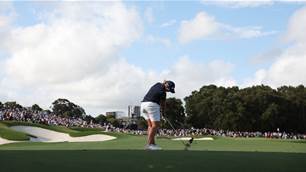Vested interests and internal politics so often distract from the simplest answers facing the game and the fact the Presidents Cup is not already a mixed event might just be Exhibit A.
Having had a couple of weeks to reflect on two hugely successful ‘Cup’ competitions it’s hard to see the sense in not completing the international team matchplay circle with an event featuring both men and women.
While the Presidents Cup solved the problem of including the best players from outside the U.S and Europe it remains ‘Ryder Cup Lite’ in the eyes of most fans (and on the results sheet, it has to be said).
The Solheim Cup might be some of the most compelling golf we’ve seen in recent years, yet it excludes a significant number of the world’s best players because they are not from the U.S or Europe.
Put those two together, peer through the lens of common sense and it seems there might be one quite straightforward solution to two quite obvious problems.
In the Solheim Cup we have a fantastic international women’s team event. In the Ryder Cup we have the same for men. As night follows day, the next logical step is to have a mixed international team event.
That would be the best outcome not for women’s or men’s golf but for golf itself.
The Presidents Cup lacks a point of difference from its hugely successful older sibling and while imitation is the sincerest form of flattery it rarely does much for the imitator.
Simultaneously, who doesn’t want to see the likes of Ruoning Yin, Jin Young Ko and Minjee Lee have a chance in this format?
"In the Solheim Cup we have a fantastic international women’s team event. In the Ryder Cup we have the same for men. As night follows day, the next logical step is to have a mixed international team event." – Rod Morri.
There are parallels between what faced the Ryder Cup in 1979 and where the Presidents Cup sits today and – as it was back then – the answer lies in the courage to be bold.
As the chair of the then GB&I Ryder Cup Committee Lord Derby said on expanding the team to include Europe:
“It was a natural step to broaden our team selection to include European players and this was undoubtedly helped by recent Spanish successes in winning the World Cup and by the achievements of Severiano Ballesteros.”
Switch out ‘European players’ for ‘women players’ and you can see the parallels.
A large part of the reason for both the lack of competitiveness and subsequent interest in the Presidents Cup is the bottom half of the two 12-man teams.
The Internationals, player for player, tend to be competitive at the top of the draw but not so much in the bottom half.
The obvious solution (and one that fits neatly into the existing golf landscape without causing any disruption) is to switch the format to six women and six men.
The top six non-European women players in the world rankings are, numerically, superior to their six U.S counterparts which would go a long way to redressing the current imbalance*.
And aside from making the matches more competitive a move to a mixed Presidents Cup would capitalise on one of golf’s most underutilised strengths: having men and women play together as opposed to ‘against’ or ‘with’ each other.
It’s hard to see the downsides of a mixed Presidents Cup and, if the world’s best women players are open to being part of it, such an event would neatly complete the circle of international team golf.
Let’s hope the fact it makes so much sense doesn’t immediately doom the chances of it happening.
*For context the eligible International women right now, according to the world rankings, would be: Ruoning Yin, Jin Young Ko, Hyo Joo Kim, Minjee Lee, Xi Yu Lin and Brooke Henderson. The six U.S Women would be Lilia Vu, Nelly Korda, Allisen Corpuz, Megan Khang, Lexi Thompson and Ally Ewing.
Related Articles

Playing From The Tips Ep.94: Webex Perth, Sony Open, TGL & more

Morri: Great golf for all












